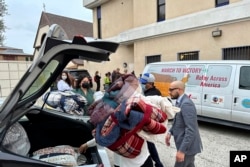In the ongoing political battle between the Biden administration and the Republican governor of Texas over border enforcement, a few sanctuary cities are caught in the middle: They welcome recently arrived asylum-seekers but often lack the money to assist their resettlement.
Since last summer, Gov. Greg Abbott has been busing migrants to cities known as sanctuaries for asylum-seekers, including Chicago, New York, Denver and Los Angeles.
Officials from these cities are asking for federal money to take care of thousands of migrants.
In New York, Mayor Eric Adams says the city’s shelter system has been overwhelmed by the nearly 100,000 migrants and asylum-seekers who have arrived since spring 2022. He is asking for federal funding and urging the federal government to expedite the processing of work permit applications so migrants can legally work in the United States.
Aaron Reichlin-Melnick, policy director at the American Immigration Council, posted on X, formerly known as Twitter, that per U.S. immigration law, migrants cannot apply for a work permit until six months after they have applied for asylum, which itself can take months.
"This should be handled at the border and ensure when people come in, number one, they should be allowed to go to the destinations that they desire and not just incentivized to go to New York or Washington or Chicago, as it currently is being put in place,” Adams said. “Then we should ensure that the entire country absorbs this influx of asylum-seekers so that we are not leaning on three cities in the northern part of the country."
What is a sanctuary city?
According to Michael Kagan, professor of law at the University of Nevada, sanctuary is a political term, not a legal one.
"Its origin is actually not in any government policy,” Kagan said. “Its origin was in civil disobedience, especially in a network of churches in the 1980s that said they wanted to provide sanctuary to Central American refugees that the government was trying to deport. And so, it was an act of civil disobedience, basically telling the government if you want this person, you're going to have to storm a church to get them."
When a city adopts a sanctuary ordinance, he said, it generally means they are not going to allow their local law enforcement to assist federal immigration officers in charge of detaining and deporting immigrants on noncriminal immigration matters.
"[But] that doesn't mean [local government] will get in their way. Local governments can't obstruct the federal government. It just means we're not going to lend you our manpower and our resources to help you do your job," Kagan said.
How many sanctuary places are there in the U.S.?
The Lutheran Immigration and Refugee Service, or LIRS, a nonprofit organization that supports refugees and migrants in the United States, said that 11 states — California, Colorado, Connecticut, Illinois, Massachusetts, New Jersey, New Mexico, New York, Oregon, Vermont and Washington — claimed sanctuary status as of March 2021. There are also many counties and cities in the United States known as sanctuaries.
"It is important to remember that sanctuary city officials do not promote breaking the law,” the LIRS website says. “Officials in these cities still take and report fingerprints to the FBI, as directed. Sanctuary policies allow local officers to decline to enforce a federal request for detention during deportation considerations. Instead of holding an individual in jail beyond the regular release date, local officials follow constitutional guidelines and their own legal regulations."
Why are migrants bused to certain cities?
Abbott began chartering buses in April 2022, sending recently arrived migrants from the southern border to Washington, New York and Chicago.
He did this after the Biden administration said it would halt Title 42 border enforcement. The pandemic-era immigration policy allowed authorities to turn away migrants at the U.S.-Mexico border. Title 42 enforcement expired on May 11.
According to Abbott, the busing program was started to prevent border communities from being overrun by asylum-seekers. His office said the bus trips are voluntary and migrants are allowed to travel only after they have been processed and released by the Department of Homeland Security. Migrants have to show documents received from U.S. immigration officials to prove they have been processed.
By October 2022, after months of migrant arrivals, New York Mayor Adams told a news conference the situation had become a crisis "created by human hands. We're going to do what we have to do in New York, but we do need help to deal with this crisis."
The New York City government has spent $1.45 billion — a mix of city, state and federal funds — in fiscal 2023 on housing, food and other services for migrants. The federal funds come from the Federal Emergency Management Agency.
In June, House Democratic Leader Hakeem Jeffries and U.S. Senate Majority Leader Chuck Schumer announced that FEMA will provide $104.6 million in additional grant funding for the care and assistance of asylum-seekers in New York.
Kagan said the help the federal government sends to states to assist migrants has nothing to do with sanctuary policies.
The assistance that New York is asking for is assistance that Abbott's jurisdiction is already receiving, he said.
Border crossings
According to the latest government data, migrants crossing the southern border without authorization increased in July after back-to-back months of low numbers. The increase in illegal crossings in July was significant and mostly made up of families. They accounted for 60,161 of the 132,652 migrants apprehended at the border.










